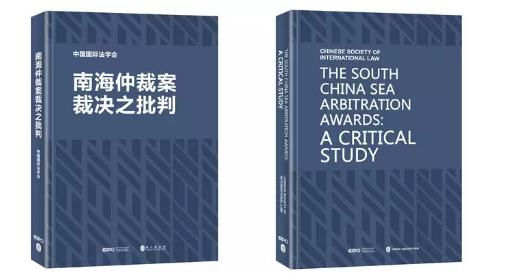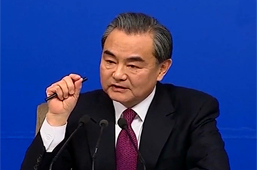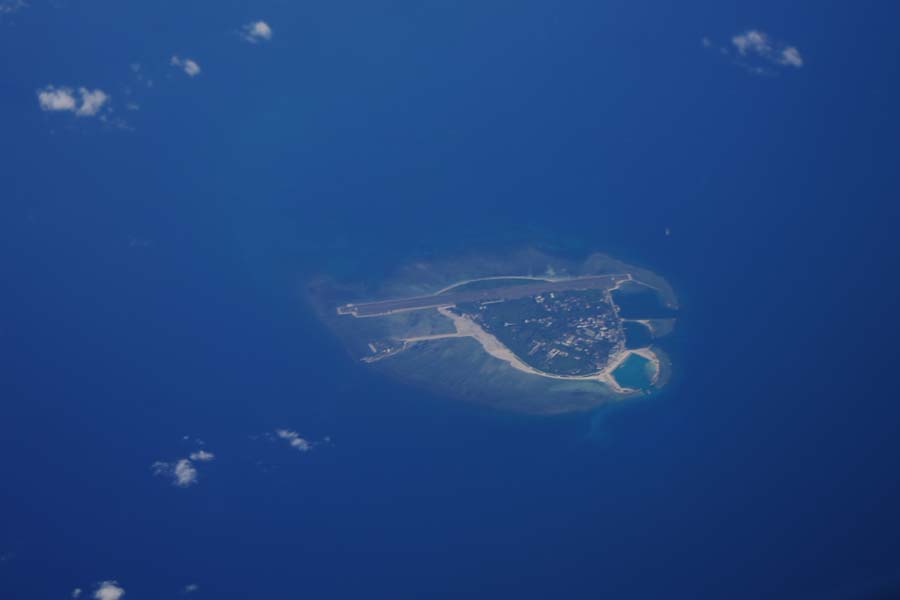A study on the South China Sea arbitration awards, compiled by the Chinese Society of International Law (CSIL), was published by the Foreign Languages Press Monday.
The book, titled "The South China Sea Arbitration Awards: A Critical Study," has both Chinese and English versions, according to a press release issued on the CSIL website.

"The South China Sea Arbitration Awards: A Critical Study" has both Chinese and English versions. [Photo/WeChat account of the Chinese Society of International Law]
The Aquino III administration of the Philippines unilaterally initiated an arbitration on disputes between China and the Philippines in the South China Sea in January 2013. The tribunal rendered two awards in October 2015 and July 2016.
Upholding its position of non-acceptance and non-participation, and objection to the arbitration being pushed forward, the Chinese government maintained that the arbitral tribunal has no jurisdiction over the claims.
China stated that the awards are null and void, and it does not and would not accept or recognize them.
Based on international laws including the United Nations Convention on the Law of the Sea and relevant international legal practices, and through a comprehensive and in-depth study, the book concluded that the arbitral tribunal has no jurisdiction and the awards are groundless both in fact and law, the statement said.
The research was also published in English by the Oxford University Press in the Chinese Journal of International Law as a special issue.
Abstract of The South China Sea Arbitration Awards: A Critical Study
I. Background to and Course of the South China SeaArbitration and the Position of the Chinese Government
China is one of the countries bordering the South China Sea. China and the Philippinesare States with opposite coasts, the distance between China’s Zhongsha Qundao and Nansha Qundao and the Philippine Islands is less than 200 nautical miles. There exists a territorial and maritime jurisdiction dispute between China and the Philippines in the South China Sea. China and the Philippines have reached agreement on resolving through negotiations and consultations the relevant disputes in the South China Sea.
On 22 January 2013, invoking Article 287 of and Annex VII to the United Nations Convention on the Law of the Sea (“UNCLOS” or “Convention”), the Aquino III government of the Philippines unilaterally initiated compulsory arbitral proceedings against China (“South China Sea Arbitration” or “Arbitration”). The Philippines deliberately mischaracterized the territorial and maritime delimitation dispute in the South China Sea between China and the Philippines, and fragmented it into several isolated disputes, and camouflaged them as disputes concerning the interpretation or application of the Convention. On 19 February 2013, the Chinese government unequivocally rejected the Arbitration. The Arbitral Tribunal constituted at the request of the Philippines (“Tribunal”) obstinately pushed forward the arbitral proceedings, in disregard of the fact that it manifestly had no jurisdiction over the relevant dispute between China and the Philippines. On 29 October 2015, the Tribunal rendered an Award on Jurisdiction and Admissibility (“Award on Jurisdiction”) and, on 12 July 2016, an Award on the merits and the remaining issues of jurisdiction and admissibility (“Award of 12 July”). China has consistently maintained its position of non-acceptance and non-participation, and its objection to the Arbitration being pushed forward. Immediately upon the issuance of each award, China solemnly stated that the award is null and void and has no binding force, and that China did not and would not accept or recognize the award.
II. Jurisdiction
The jurisdiction of an international court or tribunal over an inter-State dispute depends on the consent of the parties to the dispute. The arbitral proceedings provided in the Convention has no exception. In making its findings, the Tribunal exercised jurisdiction over matters which are not regulated by the Convention or those that have been explicitly excluded from compulsory proceedings by China. It also exercised jurisdiction over the matters which are not included in the Philippines’ submissions. The Tribunal’s foregoing findings exceed the scope of its jurisdiction under the Convention. In short, they do violence to the principle of consent.
II.1 The Tribunal had no jurisdiction over the Philippines’ submissions which reflect a territorial and maritime delimitation dispute between China and the Philippines
There exists a complex issue between China and the Philippines over territorial sovereignty and maritime delimitation in the South China Sea. This matter is beyond the Tribunal’s jurisdiction. The Philippines’ submissions constitute an integral part and reflect different aspects of this dispute and cannot be addressed separately in isolation from each other.
The Philippines deliberately fragmented the territorial and maritime delimitation dispute between China and the Philippines into various pieces, and camouflaged them as various isolated, free-standing-appearing disputes concerning merely maritime entitlements or activities at sea. However formulated, the Philippines’ submissions present questions either which themselves constitute issues of territorial sovereignty and maritime delimitation, or the addressing of which is premised on a decision on such an issue.
II.2 The Tribunal erroneously found that the Philippines’ submissions do not relate to the territorial and maritime delimitation dispute between China and the Philippines and erroneously exercised jurisdiction over these submissions
The Tribunal deliberately fragmented the territorial and maritime delimitation dispute between China and the Philippines into various pieces and addressed them in isolation, thus effecting a cover-up of the very essence of the Philippines’ submissions, which is the territorial sovereignty and maritime delimitation. The Tribunal hastily settled on the nature of relevant matters as mere disputes “concerning the interpretation or application of the Convention”, and proceeded to erroneously establish its jurisdiction. The Tribunal’s decision is thus cursory and wrong.
The Tribunal simply took at face value whatever the Philippines stated as its purpose, failed to ascertain the essence and actual objective of the Philippines’ submissions. The Tribunal found no situation in which it was convinced that the resolution of the Philippines’ claims would require the Tribunal to first render a decision on territorial sovereignty, either expressly or implicitly, nor would them infringe China’s territorial sovereignty. The Tribunal failed to do justice to China’s position and arguments.
The Tribunal misconstrued maritime delimitation, misinterpreted the optional exceptions to the compulsory dispute settlement under the Convention, and erroneously determined that the Philippines’ submissions do not relate to maritime delimitation situation. The Tribunal addressed outside the context of maritime delimitation dispute between China and the Philippines, and severed the inherent relationship among the determination of maritime entitlements, activities at sea and sea boundary delimitation. The Tribunal examined the merits of China’s rights in the South China Sea before its establishment of jurisdiction, which robbed any proper effect off China’s 2006 Declaration made pursuant to Article 298 of the Convention. The Tribunal gave short shrift to the possibility that China’s historic rights may partake of “historic title”, and that China’s historic rights may be relevant circumstances to be considered in maritime delimitation.
II.3 The Tribunal erred in finding that the Philippines’ submissions reflected the disputes as it identified between China and the Philippines concerning the interpretation or application of the Convention
The Tribunal did not adhere to the basic conditions and requirements well established in international law regarding how to determine the existence and nature of a dispute. Its decisions and reasoning are untenable in law and fact. Firstly, the Tribunal failed to demonstrate sufficiently that the dispute reflected in Submissions No. 1 and 2 concerned the interpretation or application of the Convention. Secondly, the Tribunal’s identification and characterization of disputes with respect to the Philippines’ Submissions No. 3 through 7 are not well founded in fact or law. It failed to ascertain there existed real disagreements or points of contention between China and the Philippines with regard to the matters as raised and formulated in the Philippines’ relevant submissions. It shuffled aside the standards for determining the existence of dispute, which the Tribunal itself had earlier presented. It doctored China’s position on the integral status of Nansha Qundao, and found out of thin air disagreements or points of contention between China and the Philippines on maritime entitlements.
II.4 The Tribunal erred in its decision on thechoice of means made by China and the Philippines for the settlement of disputes and its effect
The Tribunal erred in finding no agreement between China and the Philippines to settle their dispute through negotiations. It negated that the content relating to the settlement of disputes by means of negotiations in the bilateral instruments and the Declaration on the Conduct of Parties in the South China Sea (DOC) had created rights and obligations for the two countries. It erred in determining that China and the Philippines had resorted to negotiation but reached no settlement. It deliberately lowered the thresholdfor fulfilment of the obligation to exchange views under the Convention.
With regard to issues of territorial sovereignty and maritime rights and entitlements, China insists on peacefully settling disputes through negotiations and consultations and does not accept compulsory third-party procedures. The bilateral instruments between China and the Philippines and Article 4 of the DOC make it clear that the two countries committed to take negotiation and consultation as the only means to settle the relevant disputein the South China Sea.
II.5 The Tribunalerred in finding that the Philippines and China had exchanged views as requiredby Article 283 of the Convention
The obligation to exchange views is compulsory under Article 283. The Tribunal deliberately lowed the threshold of fulfillment of the obligation to exchange views under Article 283. It erroneously took the consultations between China and the Philippines concerning the issues of territorial sovereignty and maritime delimitation as the exchange of views regarding matters raised in the Philippines’ submissions.
II.6 The Tribunalviolated the non ultra petita rule and Article 10 of Annex VII to theConvention
The Tribunal had gone beyond what the Philippines asked of it in the Final Submissions in violation of the non ultra petita rule and/or the confinement requirement in Article 10 of Annex VII, with respect to its decisions and/or discussion of the status of the features which the Philippinesdid not ask the Tribunal to decide, the additional geographical areas for harmfulfishing practices, the existence or otherwise of historic rights in the South China Sea, and China’s treatment of its archipelagos each as a unit.
III. Admissibility
The Philippines were permitted to make three rounds of major amendments to its submissions presented in the Statement of Claim dated 22 January 2013 initiating this Arbitration. The first round of major amendments were made prior to the submission of the Philippines’ Memorial, the second in the Philippines’ Memorial, the third at the end of the merits hearing. The Tribunal failed to properly address the admissibility issues arising from the Philippines’ amendments to its submissions.
III.1 The Tribunal failed to properly address the admissibility issues arising from the Philippines’ amendments to its submissions
The Tribunal failed to properly address the admissibility issues arising from the Philippines’ amendments to its submissions. It tolerated for several times and even proactively guided and assisted the Philippines in making its amendments. This error started a chain of errors in its consideration of jurisdiction and admissibility, as well as the identification and characterization of disputes.
III.2 The Tribunal erred in allowing the Philippines’ amendments to its Submissions No. 11, 12(b) and 14 and finding them as formulated in the Final Submissions admissible
The Philippines’ Final Submissions of 2015 contained a number of new claims that were not found in its Statement of Claim of 2013, which included Submissions No. 11 and 12(b) accusing China of violating its obligation to protect and preserve the marine environment, and Submission No. 14 accusing China of aggravating and extending the dispute. The Tribunal erred in finding the amendments as formulated in the Final Submissions admissible.
IV. Historic Rights (Submissions No. 1 and 2)
The Tribunal erred in addressing the relationship between the Convention and historic rights and in denying the existence of China’s historic rights in the South China Sea.
IV.1 The Tribunal erred in addressing the issue of China’s historic rights in the South China Sea separately from the territorial and maritime delimitation dispute between China and the Philippines
The Tribunal’s application of the relevant articles of the Convention in addressing the Philippines’ Submissions No. 1 and 2 is based on the premise, though not stated as such, that the relevant maritime areas are the established and undisputed exclusive economic zone and continental shelf of the Philippines. However, China and the Philippines have not yet delimited the overlapping maritime areas between them.
IV.2 The Tribunal erred in its decision on the relationship between historic rights and the Convention
The Tribunal erroneously found that the Convention provided norms for settling all issues relating to the law of the sea. Article 309 of the Convention cited by the Tribunal is a provision on reservations, which is entirely a different matter with that whether the Convention regulate all issues in the law of the sea. The Tribunal erroneously interpreted Article 311 which aimed at governing the relationship between the Convention and other international agreements as regulating the relationship between the Convention and general international law.
The Tribunal held that the Convention superseded any historic rights in excess of the limits imposed therein, and that historic rights conflict with the sovereign rights of that State and thus have been superseded by the Convention. The Tribunal is wrong. According to international practice, in order to determine the nature and content of the historic rights claimed by a State, it is necessary to study the regimes of historic rights on a case-by-case basis, taking into account relevant State practice and historical and geographic circumstances of relevant areas. The Convention, alone, cannot be the basis for the Tribunal to deduce the nature and content of certain historic rights.
IV.3 The Tribunal erroneously found that China did not have any historic rights in the South China Sea
The Tribunal cherry-picked only post-2009 evidence to represent the whole of the nature and meaning of China’s historic rights in the South China Sea. This is wrong. The Tribunal also held that it was not until 2009 that the Philippines had a chance to know about the scope of China’s historic rights. Such a view is untenable.
The Tribunal erroneously found that China did not have any historic rights in the South China Sea by first predetermining the result and then pretending to ascertain that result accordingly. China’s sovereignty and maritime rights and interests in the South China Sea are established and have been consolidated in the long course of history. The Tribunal misconstrued relevant historical facts, claiming that relevant materials likeGeng Lu Bu (Manual of Sea Routes) were evidence to be considered when addressing the issue of sovereignty over islands, but that evidence has nothing to do with the question of whether China has historically had rights in the South China Sea. To the Tribunal, historical navigation and fishing, beyond the territorial sea, cannot therefore form the basis for the emergence of a historic right. The Tribunal is wrong.
V. The Status of China’s Nansha Qundao and Zhongsha Qundao (Submissions No. 3 to 7)
The Tribunal erred in addressing the status and entitlement of the relevant features of Nansha Qundao and Zhongsha Qundao separately, thereby dismembering the two archipelagos, and further erred in its interpretation and application of law, especially the “Regime of islands” under Article 121 of the Convention.
V.1 The Tribunal erroneously addressed separately the status of the component features of China’s Nansha Qundao and Zhongsha Qundao, in effect dismembering the two archipelagos and fragmenting the territorial and maritime delimitation dispute
Nansha Qundao and Zhongsha Qundao are China’ outlying archipelagos. China has sovereignty over relevant archipelagos each as an integral unit, and enjoys maritime entitlements based on the archipelagos each as an integral unit. The Tribunal erred in addressing the status of the component features of Nansha Qundao and Zhongsha Qundao separately, denying China the benefit that would come from treating an archipelago as a unit in international law.
V.2 The status of Nansha Qundao as an outlying archipelago of China, a continental State, is well founded under general international law
It has been established in customary international law that continental States’ outlying archipelagos as units are fully entitled to maritime zones.
First, the regime of continental States’ outlying archipelagos has been well established under customary international law. The general, consistent and continuing State practice and associated opinio juris are more than sufficient to establish the regime that continental States can draw baselines and claim full martitime entitlements based on their outlying archipelagos as units. The regime of continental States’ outlying archipelagos is not addressed by the Convention, but by customary international law. Thus, there is no issue of this regime deviating from the Convention.
Second, China’s Nansha Qundao is one intrinsic geographical, economic and political entity, and historically has been regarded as one entity, thus meets the criteria of archipelagos in customary international law. China has sovereignty over Nansha Qundao as a unit, and declared in accordance with international law that China has internal waters, territorial sea, contiguous zone, exclusive economic zone and continental shelf, based on Nansha Qundao.
Third, the Tribunal misinterpreted China’s position on Nansha Qundao as a unit. It erred in dismembering China’s Nansha Qundao into various individual features and applying Article 121 (Regime of islands) of the Convention, to each of them. It also erred in applying the rules on baselines in the Convention to deny China’s Nansha Qundao unity.
V.3 The Tribunal erred in separately addressing certain “low-tide elevation” components of Nansha Qundao, which would have detrimental effect on China’s sovereignty over and maritime rights and entitlements based on the archipelago
First, all the five so-called “low-tide elevations”, for instance Meiji Jiao, referred to in the Philippines’ submissions are components of China’s Nansha Qundao over which China has sovereignty. Therefore, there is no issue of whether these features individually are capable of appropriation. Regarding to the question whether low-tide elevations can be appropriated as territory, the ICJ confirmed that there existed no treaty law or customary rules with respect to the issue. The Tribunal’s decision is groundless.
Second, the Tribunal infringed China’s territorial sovereignty by severing China’s Nansha Qundao, deciding that “low-tide elevation” were the submerged landmass, and declaring that Meiji Jiao and Renai Jiao form parts of the exclusive economic zone and continental shelf of the Philippines.
V.4 The Tribunal erroneously interpreted and applied Article 121 (Regime of islands) of the Convention
First, the Tribunal erroneously interpreted and applied Article 121. It dealt with the paragraphs of this article not in a holistic manner but in isolation. It added requirements that are not contained in Article 121, departing from the intent of negotiating States and relevant State practice.
Second, the Tribunal further erroneously applied its forgoing misinterpretation of Article 121 to China’s relevant features, including confusing the objective capacity of features with their historical use; disregarding the impact of the connection between and among certain features on their capacity to sustain human habitation and their economic life; ignoring the external factors influencing the historical use of Nansha Qundao.
VI. The Legality of China’s Activities in the South China Sea (Submissions No. 8 to 14)
The Tribunal erred in finding that China’s relevant activities in the South China Sea were illegal and had “aggravated and extended” the disputes.
VI.1 The Tribunal mischaracterized and adjudicated China’s activities to affirm and safeguard its sovereignty and rights and to manage and exploit resources
The Tribunal erroneously found that relevant sea areas were within “the exclusive economic zone and continental shelf of the Philippines”. Premised on this, the Tribunal erred in applying Articles 77, 56 and 58(3) of the Convention to China’s activities to affirm and safeguard its sovereignty and rights and to manage and exploit resources in the South China Sea. The Tribunal erred in determining that China’s official vessels had carried out law enforcement activities in “the Philippines’ economic zone and continental shelf”. The Tribunal erred in characterizing that China’s activities to affirm and safeguard its sovereignty and enforce related laws and regulations at Liyue Tan, Meiji Jiao and Ren’ai Jiao, and that China’s issuance of fishing moratorium in the South China sea infringed the Philippines’ sovereign rights in its exclusive economic zone and continental shelf. There are also serious problems in the Tribunal’s fact-finding.
VI.2 The Tribunal jumped to its conclusion that Philippine fishermen had “traditional fishing rights” at Huangyan Dao
First, the Tribunal erred in disregarding the inseparability between the Philippines’ Submission No. 10 and the territorial sovereignty over Huangyan Dao.
Second, the Tribunal erred in qualifying traditional fishing rights as private rights. It misinterpreted international cases, misinterpreted and applied Article 2(3) of the Convention, and imported rashly and mechanically traditional fishing rights into the legal regime of the territorial sea.
Third, the Tribunal’s finding that the fishing activities of Philippine fishermen constituted traditional fishing is not founded in fact. In fact, none of the materials relied on by the Tribunal could demonstrate that Philippine fishermen had engaged in “traditional fishing activities” in the waters of Huangyan Dao.
VI.3 The Tribunal erred in finding that China had violated its obligations under the Convention to protect and preserve the marine environment by tolerating and protecting harmful fishing activities of its nationals and by its construction activities.
The Tribunal deliberately distorted China’s actions to affirm and safeguard its sovereignty in the incidents at Huangyan Dao and Ren’ai Jiao in an attempt to stigmatise China by accusing it of protecting harmful fishing practices. Since it did not prove that “harmful harvesting activities” had caused “pollution of the marine environment”, Article 194(5) should not have been applied. The Tribunal disregarded the facts that China had actively taken necessary legislative, executive and judicial measures to fulfill its due diligence obligation. The Tribunal’s finding that China had not taken any steps against fishermen engaged in poaching of endangered species runs counter to the facts.
The Tribunal had treated the duty of due diligence provided for in Articles 192, 194(1) and (5) of the Convention as an obligation of result rather than conduct, and relied on a dubious expert report to determine that China had violated relevant provisions in the Convention. It ignored China’s efforts to promote cooperation on the protection and preservation of the marine environment in the South China Sea. It also ignored that it is the States’ discretion in determining whether an environmental impact assessment is required.
VI.4 The Tribunal erred in characterizing China’s construction activities at Meiji Jiao as building artificial islands, installations and structures within the Philippines’ exclusive economic zone and continental shelf
The Tribunal erred in determining that Meiji Jiao, a component of China’s Nansha Qundao, was a low-tide elevation within the exclusive economic zone and continental shelf of the Philippines. It misapplied Articles 60 and 80 of the Convention, which concern only exclusive economic zone and continental shelf of coastal States, to China’s construction activities within its territory.
VI.5 The Tribunal erred in treating China’s law enforcement activities as normal navigation activities and applying Article 94 of the Convention and the Convention on the International Regulation for Preventing Collisions at Sea (the COLREGS)
The Tribunal cherry-picked two episodes from the whole of the “Huangyan Dao incident” and treated them in isolation. It mischaracterized China’s activities to safeguard its sovereignty as normal navigational ones. It applied Article 94, a provisions in Part VII “High Seas” of the Convention, directly to the territorial sea without any analysis. In disregard that COLREGS only apply to normal navigational activities, the Tribunal erroneously applied the COLREGS to China’s law enforcement activities in the “territorial sea” at Huangyan Dao. China via its law enforcement vessels was entitled to “take the necessary steps in its territorial sea to prevent passage which is not innocent” according to international law including the Convention.
VI.6 The Tribunal erred in finding that China’s construction activities on the relevant islands and reefs of Nansha Qundao had aggravated and extended the dispute
The Tribunal improperly found that there existed a geneal obligation subject to no specific limitations of “refraining from aggravating or extending the dispute” in international law. The Tribunal disregarded the fact that China’s construction activities on Meiji Jiao, Huayang Jiao, Yongshu Jiao, Nanxun Jiao, Chigua Jiao, Dongmen Jiao and Zhubi Jiao, is in essence China’s exercise of sovereignty. Its finding that China’s construction work had “aggravated and extended the dispute” was based on wrong premises. The Tribunal’s decision that China’s construction activities had “aggravated” and “extended” the dispute concerning the protection and preservation of the maritime environment was also based on wrong premises.
VII. Due Process and Evidence
The Tribunal failed to comply with the rules and practice with respect to due process and evidence. This casts serious doubt on its impartiality in the proceedings and the validity of its decisions.
VII.1 Serious violations of the requirements of due process existed in this Arbitration
The Tribunal’s findings on several important issues lack necessary reasoning. It misinterpreted various provisions of the Convention and deliberately distorted the Chinese government’s official positions without providing any reasons. It failed to provide any reason for granting the Philippines leave to amend its submissions.
It is obvious that the composition of the Tribunal does not represent geographical areas, the main forms of civilization or principal legal systems of the world. In particular, there was no member from Asia. This problematic constitution resulted in a tribunal that lacked meaningful cognizance of and thus took little account of Asian civilizations, diplomatic and legal traditions, and other regional factors which should have informed its decision making in the Arbitration. This led to many further errors in its decisions.
The Tribunal’s handling of certain procedural issues was replete with double standards and self-contradictions. The Tribunal acted without due impartiality.
VII.2 The Tribunal failed to properly fulfill the task of ascertaining that the claims are well founded in fact under Article 9 of Annex VII to the Convention
The Tribunal’s approach in dealing with the issue of evidence was inconsistent with international jurisprudence. In particular, the Tribunal’s treatment of burden of proof, standard of proof, and weight of evidence, etc., was flawed in many instances, including: obtaining important evidential materials on its own initiative, taking over the Philippines’ burden of production; allowing improperly , many times, the Philippines to submit supplemental evidential materials well beyond reasonable time-limits; appointing independent experts at the very late stage of the proceedings and the procedures of appointment were opaque; lowering deliberately the standard of proof; and that its findings of the status of relevant features and its characterization of China’s claim of historic rights were based on evidence lacking relevance, materiality or probative value.
VIII. The Tribunal’s many errors deprive its awards of validity and threaten to undermine the international rule of law
The Tribunal manifestly had no jurisdiction over the Philippines’ submissions. It acted ultra vires by effectively addressing the territorial and maritime delimitation dispute between China and the Philippines. It erred in fact-finding, law interpretation and application. Its awards on certain important issues failed to state the reasons on which they were based. The Tribunal’s relevant findings contravene the law.
The Tribunal’s awards threaten to undermine the international rule of law. Its exercise of jurisdiction ultra vires deepened the concern about “judicial activism”, and infringed the principle of sovereignty and territorial integrity. The Tribunal’s relevant findings gravely infringe the historic rights in general international law, and put in risk such rights enjoyed by States under general international law. The Tribunal erroneously denied the regime of continental States’ outlying archipelagos under customary international law. This jeopardized the legitimate rights and interests of continental States possessing outlying archipelagos. The Tribunal interpreted and applied Article 121 of the Convention in an arbitrary manner. This jeopardized the legitimate rights and interests of States having sovereignty over islands. The Tribunal’s exercise of jurisdiction ultra vires, its decision making in contravention of the law, and its law-making give a bad name to Annex VII arbitration and even the whole dispute settlement mechanism under the Convention. When interpreting and applying relevant provisions of the Convention, the Tribunal did so out of context, distorted the true meaning and spirit of the Convention, rewrote some provisions, broke the delicate balance in the Convention as well as the balance of interests between States parties, and went against the object and purpose of the Convention. The Tribunal jeopardized the integrity and authority of the Convention.
As shown in international practice, negotiation and consultation are the most effective means for the peaceful settlement of territorial and maritime delimitation disputes. Since its founding in 1949, the People’s Republic of China has successfully resolved boundary disputes with 12 out of its 14 land neighbours, delimiting and demarcating approximate 20,000 kilometres of land boundaries, which account for over 90% of the total length of its land boundaries. China and Viet Nam have delimited through negotiations and consultations their maritime boundary in Beibu Bay. In addition, China and the Republic of Korea have commenced the negotiation on maritime delimitation.
The Tribunal’s awards do not affect China’s territorial sovereignty and maritime rights and interests in the South China Sea. China’s policies and practice show that China has been making strong efforts to uphold the integrity and authority of the Convention, champion the international rule of law, and promote a peaceful and stable regional maritime order, and that this position will strengthen.
Full Text: the Chinese Journal of International Law (Oxford University Press), Vol. 17, No. 2 (2018).
https://academic.oup.com/chinesejil/issue/17/2







 Overview
Overview Resources & Environment
Resources & Environment



 QQ 好友
QQ 好友 微信好友
微信好友 易信好友
易信好友 QQ空间
QQ空间 朋友圈
朋友圈 百度空间
百度空间